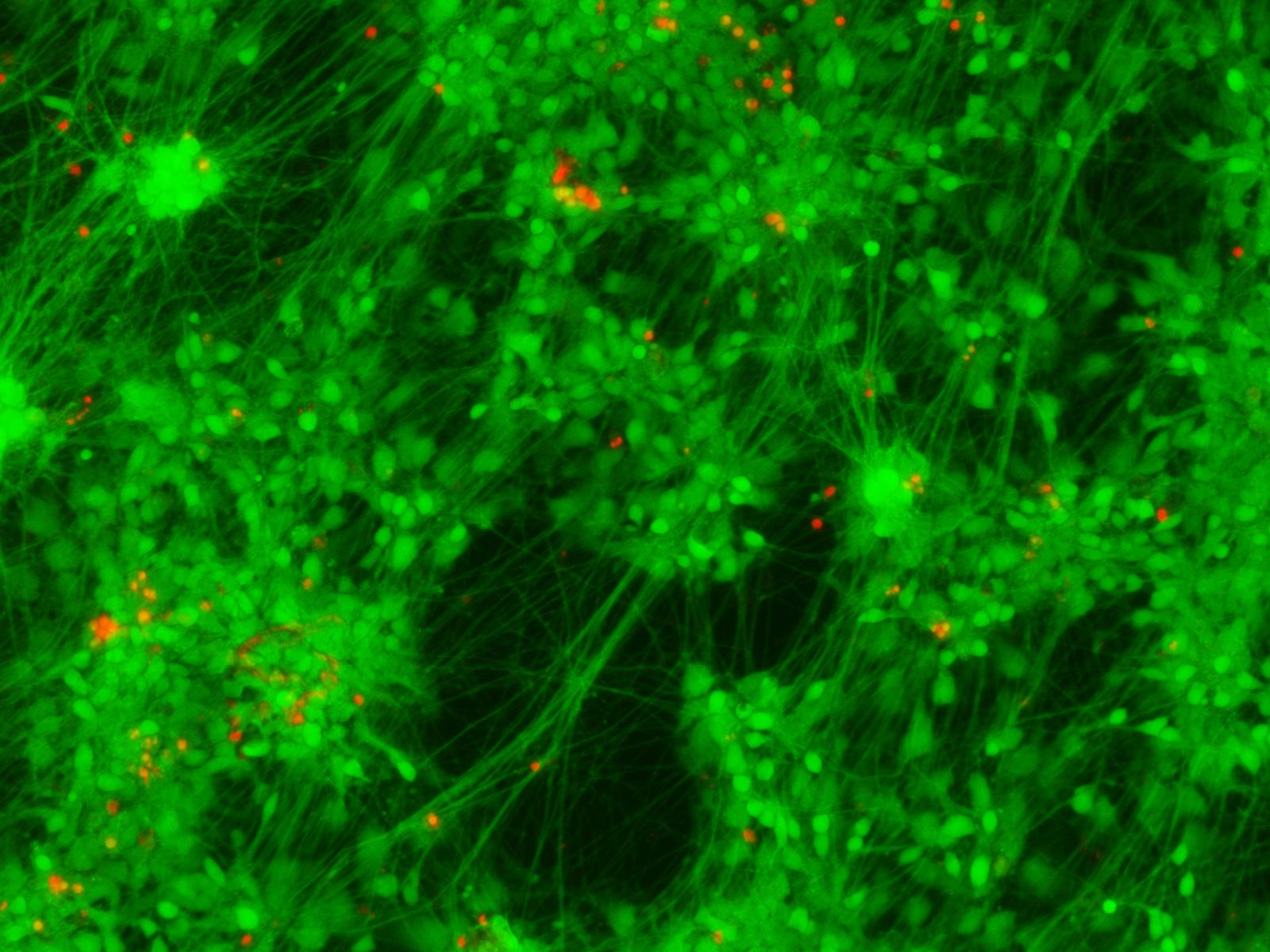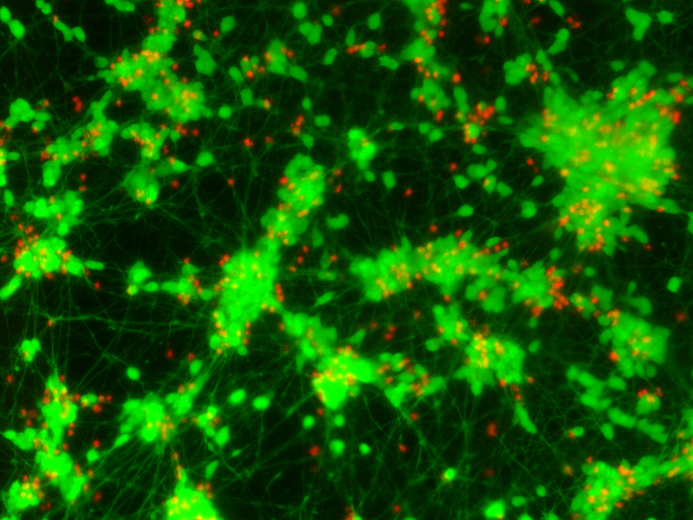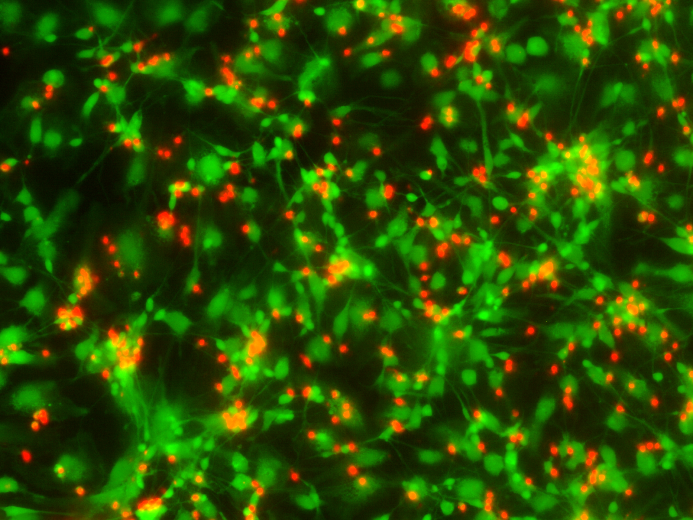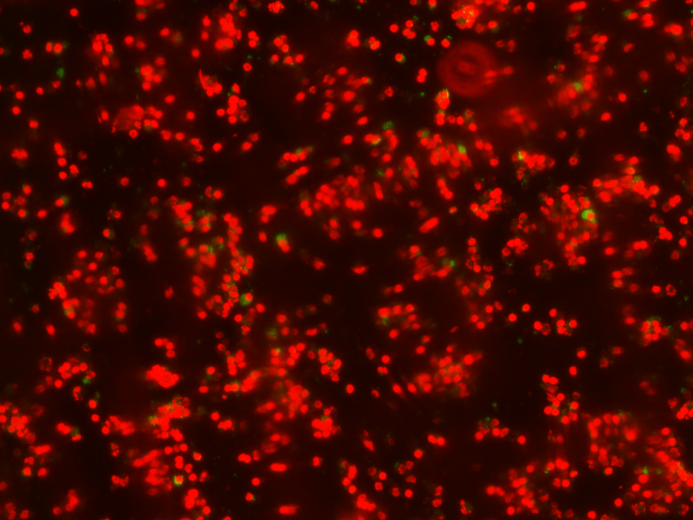Amyotrophic Lateral Sclerosis iPSC Models
Hyperexcitation Biomarker Assays
Imaging
Spinal Motor Neuron Differentiation Protocols
Optimized differentiation protocols are a prerequisite for reliable and predictive disease models. We use spinal motor neurons from BrainXell Inc. with excellent quality parameters. These cells demonstrate an extremely high percentage of spinal motor neurons.
Cultivation and differentiation protocols were optimized using our comprehensive quality control approach. Batches are quality-controlled and perform an internal release.
Electrical activity is a crucial parameter that describes the functional status of a cell culture.
As ALS is a neurodegenerative disease correlated with the age of patients, long-term experiments are essential to produce disease phenotypes; it can be supposed that in vitro models of ALS need a minimum of time to start with pathological mechanisms.

Image: Live-Dead Assay of C9orf72 spinal motor neurons after 14 div, green: living cells, red: dead cells.
Characterization of Cell lines
We continuously characterize our cell lines. We offer after-request pieces of information on the transcriptomics profiles of these cells. Further molecular biomarker characterization can be found here: Molecular readouts or imaging readouts.
Human iPSC-derived Spinal Motor Neurons Mutations
Mutations of C9orf72, SOD1, TDP43, FUS, and others cause familial ALS, which are essential and valuable for ALS disease modeling for phenotypic screening.
The mutations C9orf72, SOD1, TDP43, and FUS cover different pathological mechanisms of ALS, so phenotypic assays with these other mutated iPSC-derived motor neurons will gain predictive power.
C9orf72
The C9orf72 gene is implicated in ALS by repeating GGGGCC expansion in non-coding regions with effects on RNA binding and autophagy regulation. The C9orf72 mutation is also causing, in some cases, frontal temporal dementia.
Mechanisms: RNA processing; nucleocytoplasmic transport defects; proteasome impairment; autophagy; inflammation; protein aggregation; dipeptide repeat proteins (DPRs).
SOD1
The mutations of SOD1 affect the enzyme Cu/Zn-superoxide dismutase 1. These mutations cause the degeneration of motor neurons by oxidative stress, protein aggregates, mitochondrial defects, and glutamate excitotoxicity.
Mechanisms: Dismutase superoxide free radicals; oxidative stress; protein aggregation; mitochondrial dysfunction; axonal transport defects; proteasome impairment; glial dysfunction.
TDP-43
The TAR DNA-binding protein 43 (TDP-43) is another mutation that causes fALS.
Mechanisms: RNA processing; nucleocytoplasmic transport defects; stress granule function; protein aggregation
FUS
Fused in sarcoma RNA binding protein (a component of the hnRNP complex)
Mechanisms: RNA processing; DNA damage repair defects; nucleocytoplasmic transport defects; stress granule function; protein aggregation
ALS iPSC derived Cell-Lines
NeuroProof offers tests with the following ALS cell lines:
| Protein | Mutation/Variant | Motor neurons | Spinal astrocytes | Microglia |
| C9orf72 |
ND50001 |
studied by NPS available available available |
studied by NPS on request available available |
on request on request available available |
| SOD1 | A4V | available | on request | on request |
| D90A/D90D | studied by NPS/available | studied by NPS/available | available/on request | |
| H44R/H44H | on request/on request | available/available | available/available | |
| TDP-43 | G298S/G298G | studied by NPS/available | available/available | available/available |
| A382T/A382A | available/on request | available/on request | available/on request | |
| FUS | H517Q/H517H | on request/on request | on request/on request | on request/on request |
Co-Culture Models
NeuroProof offers ALS models as mono-culture, co-culture, or tri-culture from one genotype.
Glial cells are involved in ALS pathology. Co-culture of spinal motor neurons and glial cells are efficient tools for phenotypic modeling of ALS disease in a dish, as is demonstrated in the following example:
Example of a co-culture of C9orf72 spinal motor neurons and C9orf72 astrocytes:

Image: Live-Dead Assay of C9orf72 spinal motor neurons after 8 div, green: living cells, red: dead cells.

Image: Live-Dead Assay of C9orf72 astrocytes after 8 div, green: living cells, red: dead cells.

Image: Live-Dead Assay of a co-culture of C9orf72 spinal motor neurons and astrocytes after 8 div, green living cells, red dead cells.
Tailored ALS Cell Models
Select your specific ALS cell model from different mutations, co-cultures, and timing protocols or combine them with an additional chemical challenge such as beta-methylamino-L-alanine (BMAA).
Get in Touch
NeuroProof is continuously expanding its assay portfolio, asking us for potential new ALS cell lines with familial or sporadic forms and co-cultures with astrocytes, microglia, and oligodendrocytes. NeuroProof performs integrated projects, from sourcing diseased cell lines, cell differentiation, and assay development to compound screening campaigns..
 infobox@neuroproof.com
infobox@neuroproof.com +49 381 54345-660
+49 381 54345-660
